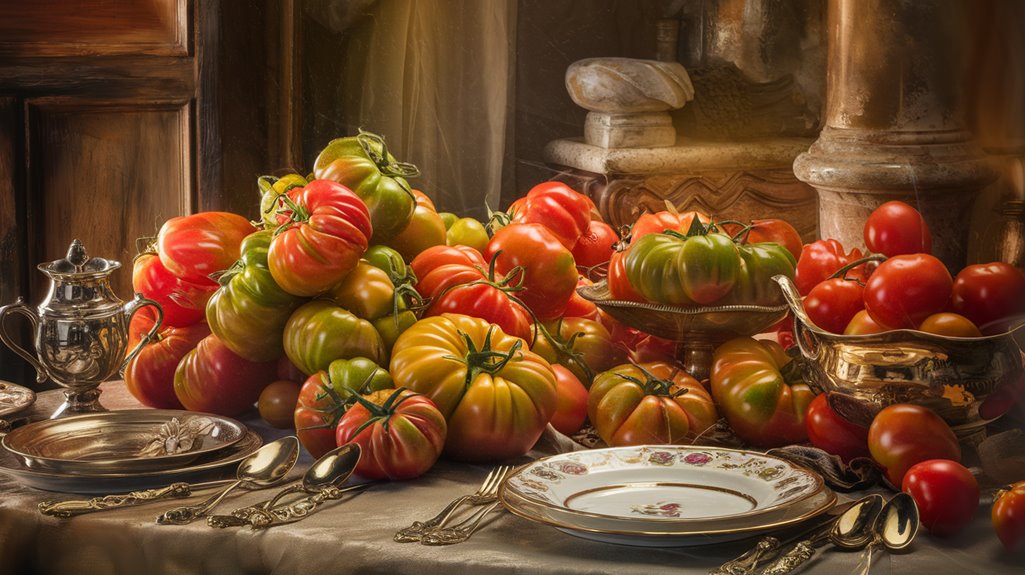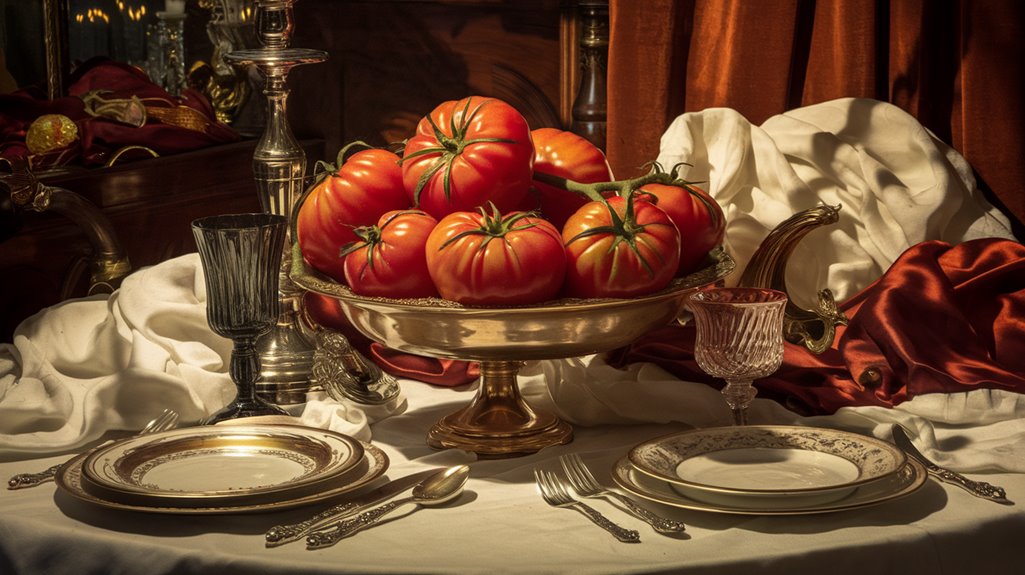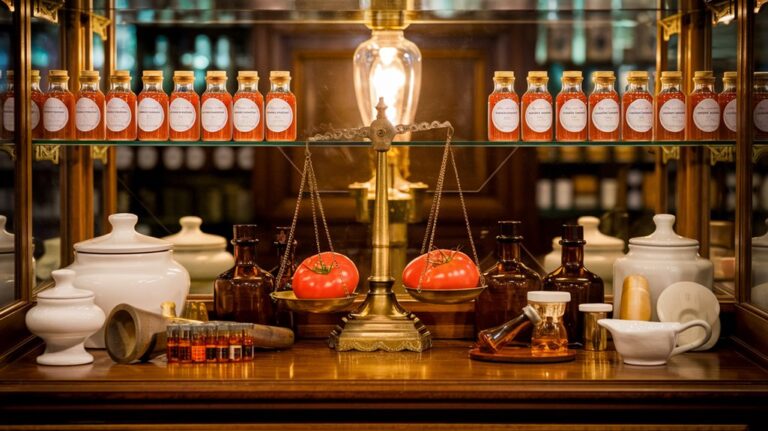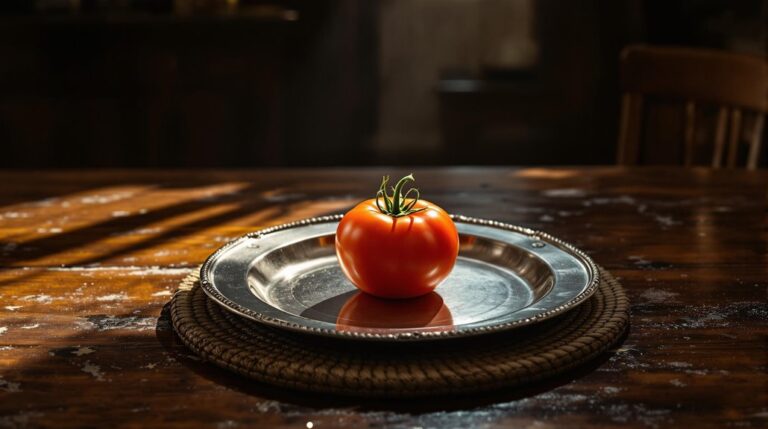The Deadly Truth About Tomatoes (They Once Killed the Rich)
Like Eve's forbidden fruit in the garden, the tomato once sparked fear and suspicion among Europe's elite. You wouldn't think twice about adding fresh tomatoes to your salad today, but in the 18th century, this seemingly innocent fruit sparked panic in aristocratic circles. As wealthy nobles dropped dead at their dinner tables, whispers spread about the deadly "poison apple" that had infiltrated their kitchens. The truth behind these deaths, however, wasn't quite what it seemed.
The Tomato's Journey From Beauty to Beast

While most people today enjoy tomatoes as a culinary staple, these fruits weren't always welcomed with open arms.
Despite their ancient botanical origins in South America, where they evolved naturally around 80,000 years ago, tomatoes faced fierce opposition when they reached European shores in the 16th century.
The dramatic shift in cultural perceptions began when botanist Pietro Andrae Matthioli classified tomatoes as members of the deadly nightshade family.
This unfortunate categorization, combined with John Gerard's plagiarized and inaccurate information in his influential "Herball," sparked widespread fear.
Though only the plant's leaves and stems contained toxic compounds, Europeans believed the fruits would kill them. When wealthy aristocrats began dying mysteriously, their deaths were blamed on tomatoes, but the true culprit was the lead in plates they used for dining.
These misconceptions persisted for over two centuries, making the tomato's journey from a wild South American plant to a feared "deadly fruit" one of history's most fascinating botanical tales.
Modern science has revealed that tomatoes belong to the genus Solanum along with other common vegetables like peppers, potatoes, and eggplant.
Noble Deaths and Pewter Plates: A Fatal Connection
Although European nobles blamed tomatoes for mysterious deaths among the aristocracy, the true culprit lurked in their elegant dining ware. When you served acidic tomatoes on pewter plates, they'd leach toxic lead into the food, leading to numerous noble poisonings. The wealthy didn't realize their prized plates were slowly killing them.
These aristocratic meals became deadly affairs, but not because of the tomatoes themselves. The combination of acidic foods and lead-rich pewter created a poisonous mix that accumulated in their bodies over time. Early Europeans only grew tomatoes as ornamental plants, believing them to be too dangerous to eat. The lower classes who used wooden plates avoided these deadly poisonings entirely.
While miners and potters faced greater lead exposure risks, the aristocracy's dining habits contributed to their demise. This misunderstanding led to tomatoes being dubbed "poison apples," and their reputation wouldn't recover until safer dinnerware became common and botanical knowledge improved.
Scientific Confusion and the Nightshade Family
The scientific classification of tomatoes within the Solanaceae family, which includes about 2,300 flowering plant species, didn't help their reputation.
While it's true that tomato leaves and stems contain toxins, and some nightshades like deadly nightshade (Atropa belladonna) are genuinely poisonous, the fruit itself is perfectly safe to eat. The active compound solanine in nightshades can be lethal in high doses.
Modern science has clarified that edible nightshades, including tomatoes, potatoes, and eggplants, pose no threat when properly prepared and consumed. The tomato belongs to the largest genus in the nightshade family, known as Solanum, which contains approximately 1,500 species.
The Green Tomato Worm: Myths and Panic
During the height of tomato fear in the 1800s, a peculiar panic spread across America about the green tomato hornworm, a large caterpillar that became the subject of wild speculation and terror.
You'd hear tales of these mythical creatures supposedly killing anyone who dared touch them, with even respected figures like Ralph Waldo Emerson buying into the hysteria.
This piece of culinary folklore claimed the 4-inch, blue-green caterpillars could poison tomatoes simply by crawling on them. They're particularly distinctive with their seven white stripes running along each side of their body.
In reality, while these hornworms can damage your tomato plants by devouring leaves and scarring fruit, they're completely harmless to humans. These voracious eaters can completely defoliate plants in just a few days if left unchecked.
Entomologist Benjamin Walsh later debunked these fears, revealing that these impressive creatures, which transform into large hawkmoths, were merely garden pests that you could safely remove by hand.
From Feared Fruit to Kitchen Staple

While today's kitchen wouldn't feel complete without a bowl of fresh tomatoes, these vibrant fruits once struck terror into European hearts. In the 18th century, wealthy Europeans often died after eating tomatoes, not because the fruit was poisonous, but due to their fancy pewter plates that leached toxic lead.
The Aztecs were the first to cultivate tomatoes and called them tomatl in Mesoamerica. The culinary evolution of tomatoes took a dramatic turn in Naples with the invention of pizza. When chef Raffaele Esposito created a dish showcasing the Italian flag's colors, he transformed the tomato's cultural significance forever. Queen Margherita of Italy's endorsement of this new dish helped establish the royal seal of approval for tomatoes.
You might be surprised to learn that before this shift, tomatoes were merely ornamental plants in European gardens. Today, you'll find these nutrient-rich fruits – packed with vitamins C and E, potassium, and antioxidants – starring in countless recipes worldwide.
Historical Lessons in Food Safety and Misinformation
Throughout history, fear and misinformation have shaped society's relationship with food safety, as demonstrated by the infamous tomato saga. Before modern scientific understanding, people often made dangerous false connections between foods and illnesses, leading to widespread panic and cultural stigmas that could last for centuries.
You can see this pattern clearly in how wealthy Europeans wrongly blamed tomatoes for deaths that were actually caused by lead poisoning from their pewter plates. This misunderstanding highlights the critical importance of public education and scientific research in preventing food safety myths. Modern investigations have revealed that fresh tomatoes have been linked to twelve Salmonella outbreaks in the past decade alone. The horrific Jack in the Box outbreak of 1993, which claimed the lives of four children, serves as a stark reminder of how dangerous foodborne illnesses can be.
From the Salem Witch Trials' ergot-contaminated rye to the tomato scare, these historical lessons remind you that proper food safety knowledge isn't just about preventing illness—it's about protecting communities from devastating misinformation that can impact entire societies.










